Three horns and twelve tons of fun, Triceratops is one of the best-known dinosaurs, spotted everywhere from museums to picture books, toy stores to cinema screens. Because of this, and because a large number of specimens have been unearthed, Triceratops is also a much-loved and well-studied species with a number of intriguing questions still up for debate.
Roughly the size of an elephant, this hefty herbivore walked on four legs and lived around the same time as the T. rex, ultimately succumbing to the asteroid strike that wiped out all non-avian dinosaurs at the end of the Cretaceous period.
Part of the Ceratopsidae family of horny quadrupeds, its name literally means Three Horn Face, which sounds like a nickname it was given at school, but of course references its distinctive appearance, including a bony frill that extended from the top of its skull.
"It's a fabulous looking animal," says Prof Paul Barrett, a palaeontologist at the Natural History Museum in London. "It's kind of like a cross between a rhinoceros and a unicorn. For me, one of the reasons I like it is it almost looks like a heraldic beast. You can imagine having a Triceratops skull on your coat of arms."
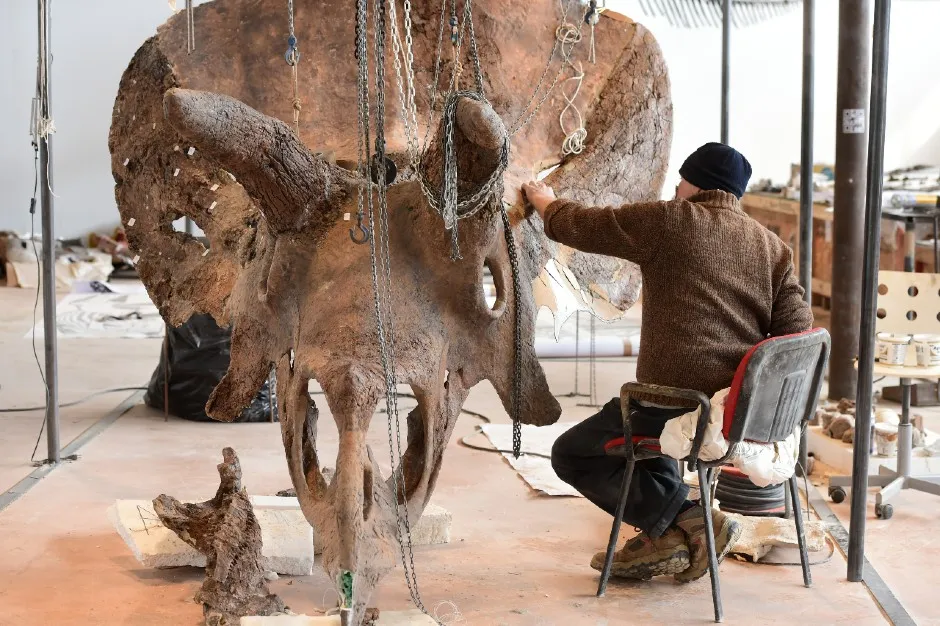
Triceratops skull
Triceratops had a big head. Its skull was one of the largest of any land animal known to science and particularly big relative to the size of its body. "It took up about a quarter of its whole body length, which is an unbelievably big skull," says Barrett.
The skull is also what makes Triceratops so memorable, with its bony frill and three dramatic horns. It's easy to assume that its fearsome features were used in prehistoric battles with predators like the T. rex and while that may be true, their function is more complicated, says Barrett.
"As with many of the things we see in the natural world, there was probably more than one use of the horns," he says. "I suspect they are something to do with signalling, for showing off to other Triceratops and potentially for shoving or battling contests over territory or mates or food resources."
The horns are robust enough to have had a role in defence, Barrett says, but they probably evolved for display purposes. "Defence was probably an added benefit. The reason for thinking that is when we look at living animals that have similar large horns such as antelope, it does look like those horns are used primarily for sexual display and territorial display – but then they do come in useful for fending off the odd lion."
The frill, on the other hand, was large but not particularly thick or strong. Palaeontologists once considered that it was used for defending the animal's neck but again display seems more likely. "It's not only Triceratops but all of its relatives have different arrangements of horn, the size of the frill varies, the spikes around the edge vary. And we think they used them as species-specific signalling to each other," Barrett says.
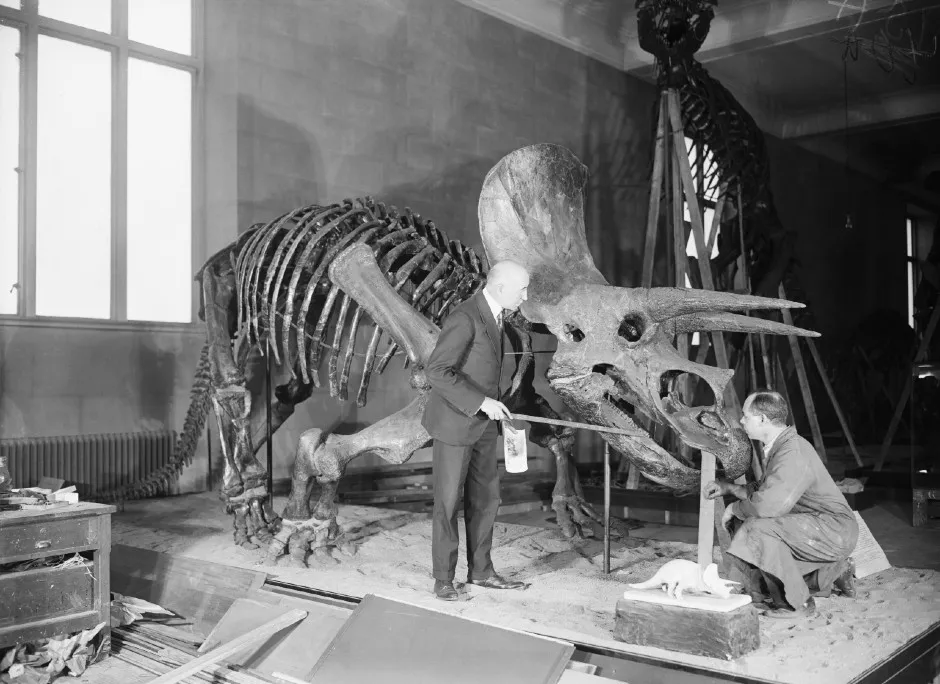
Triceratops skeleton
Many Triceratops fossils have been found in North America since the species was first unearthed in 1887. Its large, heavy-set body could grow to 9m in length and 3m in height, comparable with an African elephant, and it walked on four strong legs, rather like a rhinoceros.
"There's been a long debate on whether the front legs of Triceratops were held in a kind of elbow-bent position or more upright like an elephant," Barrett says. "Most people have come to the conclusion that they have these bent front legs, more crouched. That means these animals were probably not quite as agile as has been portrayed in the past. They're a bit slower and more ungainly, rather than galloping around."
Another interesting point about Triceratops fossils is that they're usually found on their own. "We don't normally find herds of them," Barrett says. "In fact, I think there's only one example of finding two or three together. So unlike a lot of plant-eating dinosaurs they mainly hung out on their own rather than in large herds. That's slightly unusual and we don't know why."
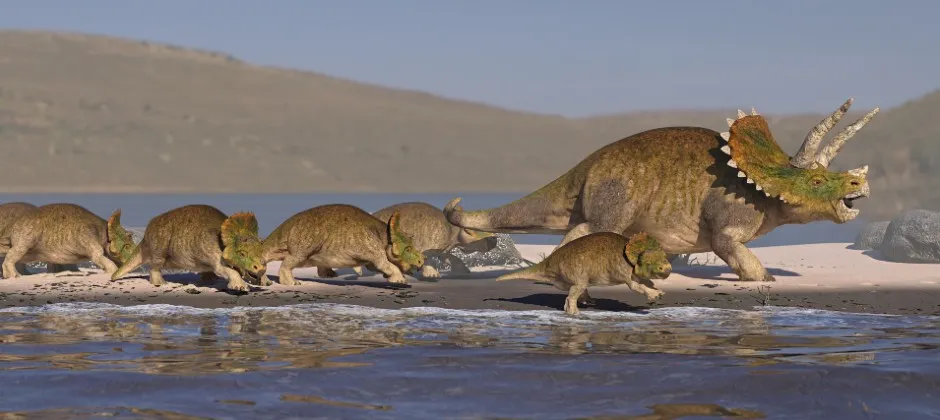
Baby Triceratops
A hatchling Triceratops is thought to have been around the size of a bulldog. Few fossils have been found compared with adults, and palaeontologists are still piecing together how the animal developed to the size of an armoured tank.
One clue comes from the fossil of a young Triceratops found in 1997. Thought to be one year old when it died, the skull is a fraction of the size of an adult's and doesn't have extended horns, which are thought to have grown with age.
When did Triceratops live?
Triceratops walked the Earth around 68 million years ago, evolving right at the end of the Cretaceous period shortly before nature brought the curtain down (well, an asteroid) on the age of the dinosaurs.
"It's a very familiar dinosaur but it was only around 2-3 million years," Barrett says. "It's one of the animals that was alive when the asteroid hit. They were very, very common but they weren't around for very long. They were probably snuffed out by the asteroid."
It's actually a Triceratops fossil that is the 'youngest' known to science. "[It] is the closest dinosaur fossil we have below the boundary layer caused by the asteroid impact," says Barrett.
They were alive right until the end, but they certainly weren't alone. Triceratops was a direct contemporary of T. rex.
“That classic scene of a battle between aTyrannosaurusand aTriceratopsis one that you see a lot in paleo art,” Barrett says. “And it’s probably something that did actually happen. There areTriceratopsbones withT. rexteeth marks, so there is some evidence that those two would have squared off.”
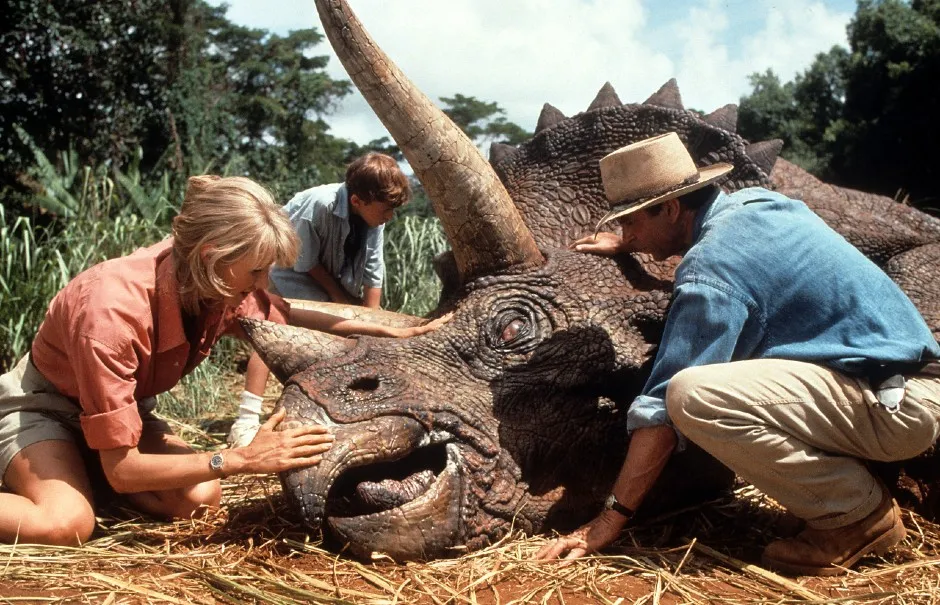
What did Triceratops eat?
As a herbivore, Triceratops ate plants such as low lying shrubs. Its parrot-like beak was used to slice and chew its dinner, while palaeontologists also believe that its long horns may have been useful for reaching and dislodging plants higher from the ground.
Read more:
- The scary truth about the Velociraptor
- What was the first dinosaur?
- Jurassic World: Could we really resurrect a dinosaur?
What were Torosaurus and Nedoceratops?
Triceratops had a lot of relatives, other Ceratopsidae and beyond, with frills and horns set in different configurations. Since the first Triceratops was found, a number of specimens were initially thought to have been separate species, with various names proposed.
"After a lot of study that number basically came down to one," Barrett says. "It's thought that all the differences that people see could be because the bones get slightly bent in the ground or maybe that those differences are because of different growth stages."
However, while most palaeontologists believe that the majority of specimens form a single species, there are a couple of skulls that are still the subject of discussion. "There's an active area of debate about whether another species of horned dinosaur called Torosaurus is actually a really large, old form of Triceratops," Barrett says. "That debate swings backwards and forwards and there's no real consensus on that question yet, but for what it's worth, I think they're probably different."
Another skull described as Nedoceratops is similarly controversial. It has subtle differences, such as straight horns instead of curved ones, but it's the only known specimen, and some palaeontologists believe it simply to be an unusual individual rather than a distinct species.
Other horned dinosaurs
Styracosaurus

Another Ceratopsian dinosaur from the Cretaceous period, this one gets its name from the ancient Greek for "spiked lizard", and for obvious reasons. Styracosaurus had a head that looked like a Medieval weapon, with four to six long spikes protruding from its frill, two more from its cheeks and another long one from the end of its nose.
Protoceratops
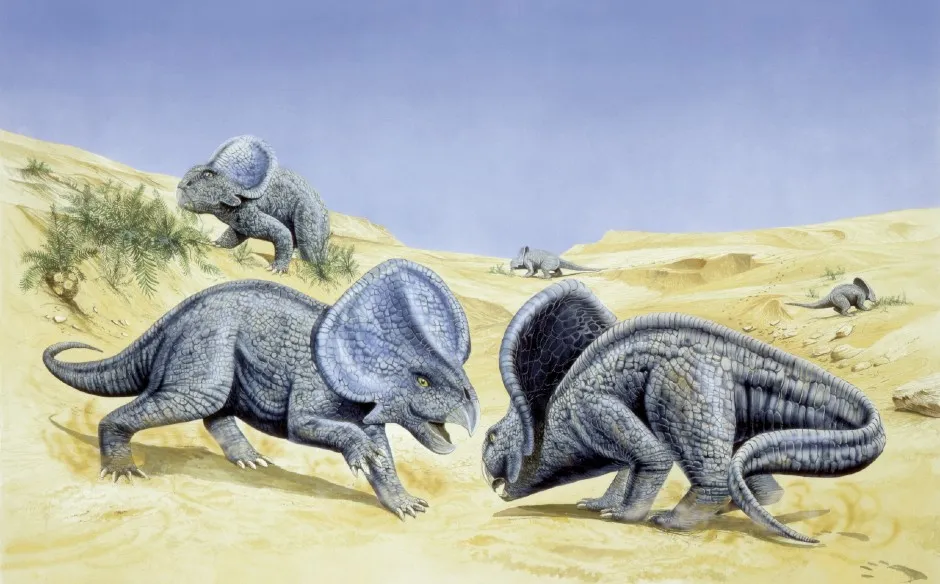
Older and much smaller than a Triceratops, this species discovered in modern Mongolia was about the size of a sheep. Like Triceratops, it had a large head with a large frill, but its horns were far less pronounced.
Centrosaurus
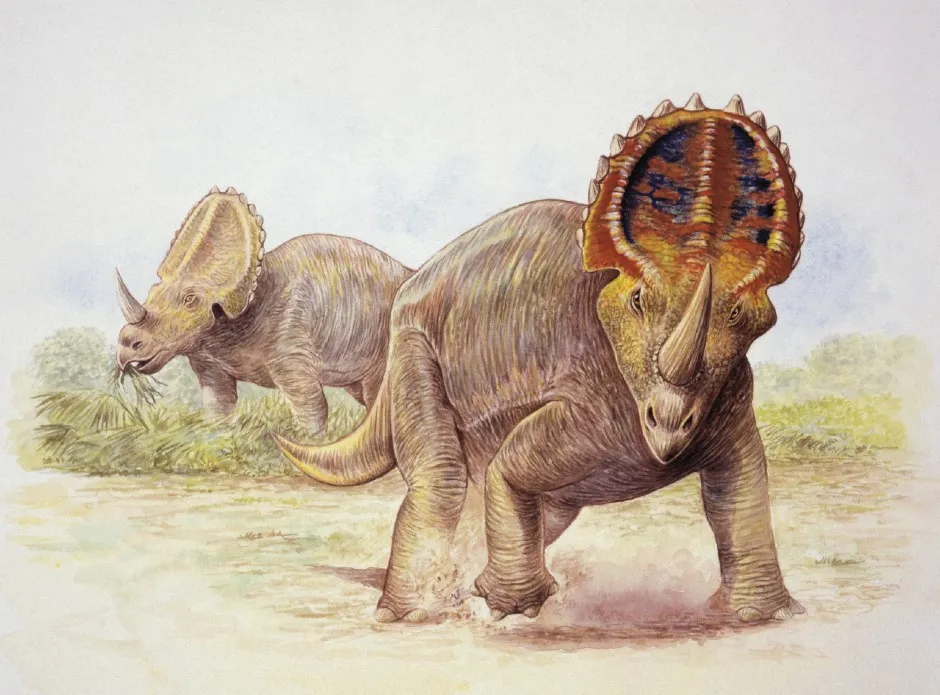
Around 5.5m in length, this mid-sized Ceratopsian had one long horn at the end of its nose, two smaller ones above its eyes and two curved hornlets on its frill. Centrosaurus remains have been found in large clusters known as bonebeds in Canada, where researchers speculate that the high number of specimens found together may be due to many animals drowning while attempting to cross a river.
Pentaceratops

The Pentaceratops is all about its fabulous frill which extended for higher above the head than a Triceratops. It featured two holes in it and was ringed by small triangular spikes. In addition, the species had five horns upon its head.
About our expert, Prof Paul Barrett
A palaeontologist at the Natural History Museum in London, Prof Paul Barrett researches evolutionary palaeobiology of dinosaurs and other extinct creatures. He also edits a number palaeology journals.
Learn more about dinosaurs:
